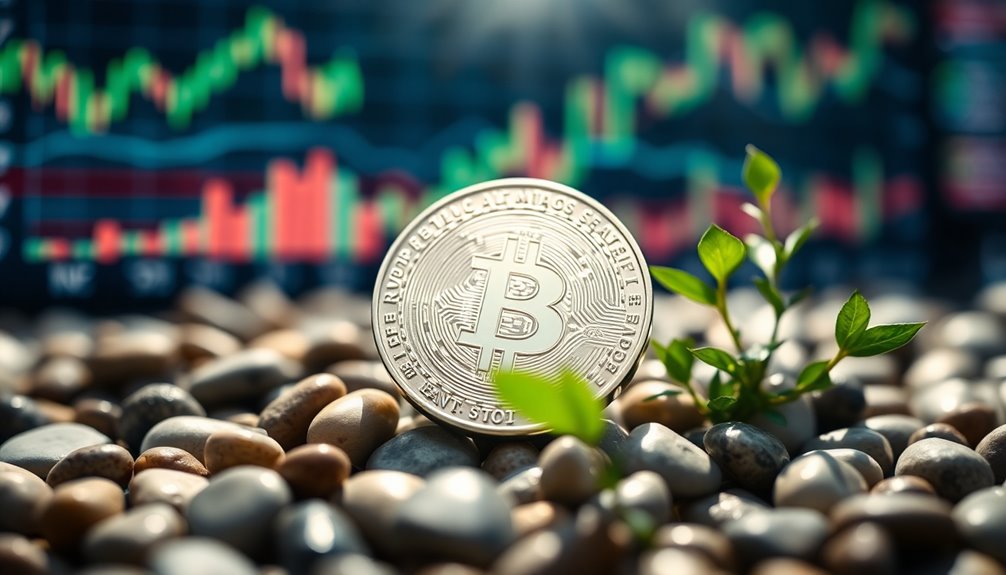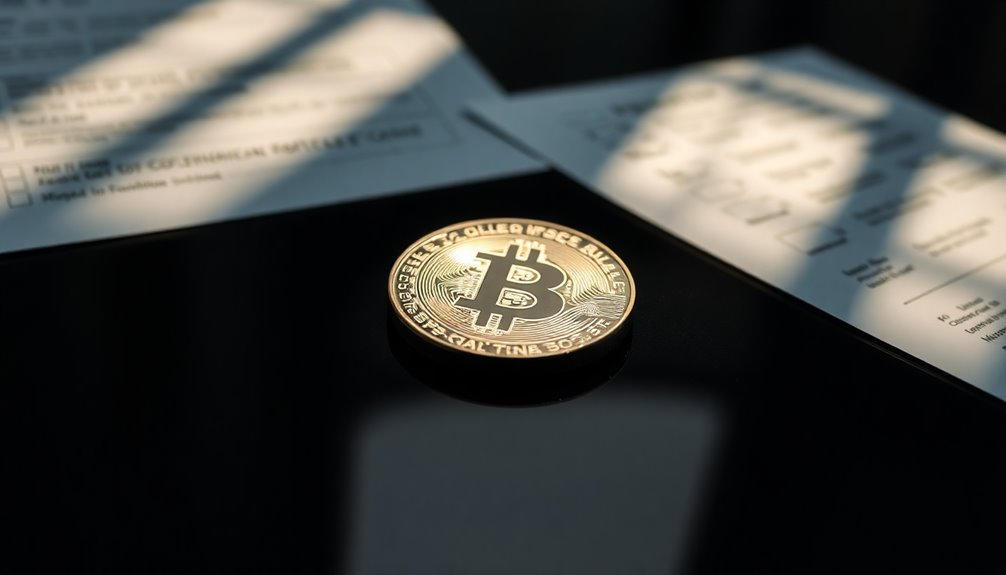When you're exploring stable cryptocurrencies, focus on stablecoins like USDT and USDC. These coins are designed for price stability, offering a reliable bridge between crypto and fiat currencies. They achieve this by being pegged to stable assets, ensuring you can enjoy fast, low-cost transactions without the wild price swings. The market's dynamics, such as liquidity and demand, play a crucial role in their performance. Always consider the underlying mechanisms for value stabilization and audit histories. If you're curious about how to choose the right stablecoins and manage your portfolio effectively, there's plenty more to uncover.
Key Takeaways
- Stablecoins, like USDT and USDC, are designed for price stability by pegging to stable assets, primarily fiat currencies.
- Adequate collateralization is critical for maintaining the peg and ensuring the value of stablecoins remains consistent.
- Algorithmic mechanisms and arbitrage strategies help stabilize prices and manage supply based on market demand.
- High liquidity in stablecoins facilitates fast, low-cost transactions, making them appealing for trading and decentralized finance applications.
- Regular audits and a transparent framework enhance trustworthiness and reliability in the stablecoin market.
Stablecoin Characteristics

Stablecoins are designed to maintain price stability, which makes them stand out in the often volatile cryptocurrency market. They achieve this by pegging their value to stable assets like fiat currencies or commodities. This pegging mechanism reduces volatility, making stablecoins ideal for everyday transactions. To maintain their peg, these coins require adequate collateral, such as fiat or other digital assets. While they provide stability, factors like market fluctuations can still impact their value. Some stablecoins use algorithmic formulas to manage supply and ensure price consistency. Their integration into decentralized finance applications enhances liquidity, enabling quick trades without needing to convert to fiat. Overall, stablecoins offer a reliable solution in the ever-changing crypto landscape, especially given their growing use in remittances and payments.
Overview of Stablecoin Importance

In a world where cryptocurrency volatility can be daunting, stablecoins emerge as a crucial solution for both users and investors. They bridge the gap between cryptocurrencies and fiat currencies, offering stability that reduces the risks associated with price fluctuations. Accessible globally and available 24/7, stablecoins facilitate fast, low-cost international transactions, making them ideal for those in regions with monetary instability. Their programmability allows for diverse applications in decentralized finance and smart contracts. As a reliable store of value, especially in high-inflation areas, stablecoins attract users seeking to protect their assets. By providing a stable alternative, they enhance the overall cryptocurrency ecosystem, appealing to investors and everyday users alike. Additionally, stablecoins often aim to reduce volatility compared to traditional cryptocurrencies, providing users with a more predictable experience. Moreover, as traditional financial systems face challenges, stablecoins present alternative cryptocurrencies to consider for those seeking a reliable digital asset. Their ability to maintain a stable value facilitates easier budgeting and financial planning, particularly in uncertain economic climates. Consequently, as the demand for security and predictability in the cryptocurrency market rises, stablecoins are likely to play an increasingly vital role in shaping the future of digital finance.
Mechanisms of Value Stabilization

While the need for stability in the cryptocurrency market is clear, various mechanisms exist to ensure that stablecoins maintain their value.
You'll find collateralization as a common approach, with fiat-backed, crypto-backed, and commodity-backed stablecoins offering different forms of support. Additionally, the surge in issuance from $3 billion in 2019 to $125 billion in 2023 highlights the growing reliance on these mechanisms.
Arbitrage plays a crucial role too; traders capitalize on price discrepancies to help maintain the peg.
Algorithmic adjustments dynamically alter supply based on demand, ensuring stability through smart contracts.
Lastly, decentralized stabilization uses smart contracts and decentralized oracles to manage value without centralized control.
Each of these mechanisms contributes to the overall stability of stablecoins, allowing you to navigate the cryptocurrency landscape with more confidence.
Pros and Cons Analysis

Understanding the mechanisms that help stabilize cryptocurrencies reveals both advantages and challenges associated with stablecoins.
On the plus side, their price stability makes them ideal for everyday transactions, while their speed and efficiency enable quick, low-cost payments. Transparency and security are enhanced through blockchain tracking, and stablecoins provide versatility in decentralized finance (DeFi) applications. This is especially important as they are often seen as a safer alternative during times of market volatility.
However, you need to consider the drawbacks as well. Trust in third parties can lead to collateral risks, and regulatory uncertainty might impact their value. Security risks, including potential hacks, pose concerns, and algorithmic stablecoins face de-pegging risks. Finally, the volatility of underlying assets can also affect the stability you expect from them. Balancing these pros and cons is crucial for informed decision-making.
Stablecoin vs. Traditional Currencies

How do stablecoins stack up against traditional currencies in today's financial landscape?
Stablecoins aim to provide stability and mitigate the volatility associated with cryptocurrencies. They often peg their value to fiat currencies like the US dollar, using mechanisms such as fiat collateralization or crypto collateralization. For instance, USD Coin is partially backed by reserves, while others may use commodities like gold. Stability mechanisms like these are crucial for ensuring that stablecoins can function effectively as a medium of exchange.
Unlike traditional currencies, which can be influenced by economic factors, stablecoins strive to maintain a consistent value through various stabilization methods. However, risks like counterparty issues or market fluctuations can still affect them.
As stablecoins gain traction for international payments and liquidity management, they're positioning themselves as viable alternatives to traditional currencies.
Regulatory Compliance Hurdles

As stablecoins increasingly position themselves as alternatives to traditional currencies, regulatory compliance hurdles become more pronounced.
You'll find that the decentralized nature of these assets complicates identification of parties involved in transactions, creating difficulties for regulators. With governments struggling to keep pace with technological advances, unclear guidelines emerge, allowing for potential misuse in illicit activities like money laundering. The rapid growth of crypto assets creates compliance difficulties for banks, further complicating the regulatory landscape.
The anonymity inherent in cryptocurrencies raises privacy concerns, making anti-money laundering and counter-terrorism efforts challenging.
Additionally, the fragmented regulatory landscape intensifies compliance complexity, as multiple authorities may oversee transactions.
As expectations rise, financial institutions must navigate high levels of supervision while developing effective risk and compliance strategies to meet evolving regulatory demands.
Emergence of Algorithmic Stablecoins

With the rise of digital currencies, algorithmic stablecoins have emerged as innovative solutions aimed at maintaining price stability without relying on traditional collateral. These digital currencies use smart contracts to adjust supply dynamically based on market demand, ensuring their value stays close to pegged assets like the US dollar. By operating in a decentralized manner, algorithmic stablecoins enhance transparency and eliminate the need for third-party involvement. Additionally, they play a crucial role in the growth of DeFi applications, which further illustrates their significance in the cryptocurrency ecosystem. Their operation relies on the principles of blockchain technology, which provides a secure and transparent framework for transactions.
They offer capital efficiency and scalability, adapting automatically as demand shifts. However, their weak architecture poses risks, making them vulnerable to de-pegging and market fluctuations. Understanding these mechanisms is crucial for you as you navigate this evolving landscape of stablecoins.
Diversify Your Stablecoin Portfolio

Diversifying your stablecoin portfolio is essential for mitigating risks and maximizing potential returns in a volatile market.
By including stablecoins with high liquidity, like Tether (USDT) and USD Coin (USDC), you ensure ease of trading without significant price impacts. Additionally, the choice of stability mechanism used by each stablecoin plays a crucial role in maintaining their value stability.
Consider combining large-cap coins with smaller-cap options, such as Frax (FRAX), to enhance resilience against market fluctuations. Always prioritize stablecoins backed by robust reserves and those adhering to regulatory standards for added security.
Look for coins that undergo regular audits to maintain transparency and trust.
Frequently Asked Questions
How Do Stablecoins Differ From Traditional Cryptocurrencies?
Stablecoins differ from traditional cryptocurrencies mainly in their stability.
While cryptocurrencies like Bitcoin can experience extreme price fluctuations, stablecoins aim to maintain a fixed value by pegging to assets like fiat currencies or commodities.
This peg reduces volatility, making stablecoins more suitable for everyday transactions.
You'll find that stablecoins offer predictable value, which enhances market confidence, while traditional cryptocurrencies often serve as speculative investments rather than stable mediums of exchange.
Are Stablecoins Suitable for Long-Term Investment?
Stablecoins can be suitable for long-term investment, but you should weigh the risks carefully.
Their market performance shows potential for growth, and they offer advantages like instant asset movement and lower transaction costs.
However, you need to consider market and operational risks, as well as regulatory uncertainties.
If you're seeking stability and liquidity, stablecoins might fit your strategy, but don't overlook the potential vulnerabilities in this evolving landscape.
What Risks Are Associated With Using Stablecoins?
When you use stablecoins, you face several risks. Redemption isn't guaranteed, especially during market runs, leading to potential losses.
Cyber-attacks and fraud are heightened due to unregulated issuers, making your assets vulnerable.
Regulatory uncertainty can create instability, causing confidence to wane.
Additionally, if reserves are mismanaged, the stablecoin's value might fluctuate unexpectedly.
Understanding these risks is crucial before diving into the world of stablecoins for your investments.
Can Stablecoins Be Used for Everyday Purchases?
Imagine walking into your favorite coffee shop, ordering a latte, and paying with a digital dollar.
You can use stablecoins for everyday purchases at numerous retailers, from Burger King to Best Buy. Just ensure your digital wallet supports the stablecoin you've chosen.
With quick transactions and minimal fees, stablecoins make shopping seamless and convenient.
How Do I Buy and Store Stablecoins Securely?
To buy and store stablecoins securely, start by choosing a reputable exchange like Binance.
Deposit fiat using bank transfers or e-wallets. Once your account's funded, purchase your desired stablecoin using a credit or debit card.
For storage, select a reliable wallet and enable two-factor authentication to enhance security.
Regularly monitor your wallet activity and keep your software updated to protect against potential threats.
Always back up your wallet to prevent data loss.
Conclusion
So, you're all set to dive into the glamorous world of stablecoins, huh? Just remember, while you're busy diversifying your digital treasure chest, these coins aren't magic beans that'll sprout into a money tree overnight. They're more like the reliable friend who never shows up to parties but always texts "I'm here for you." Embrace the stability, dodge the drama, and don't forget to check your regulatory homework—because nobody wants a surprise audit at the crypto bash!









